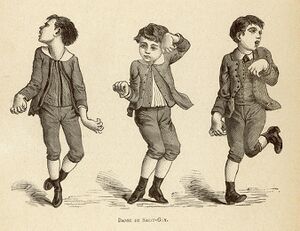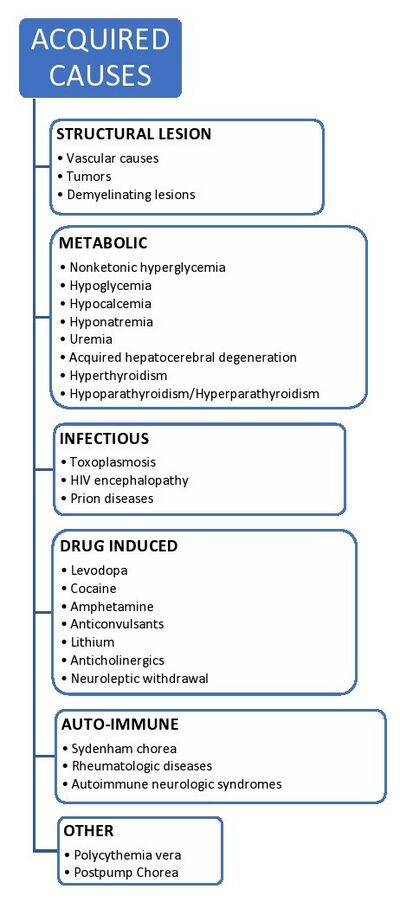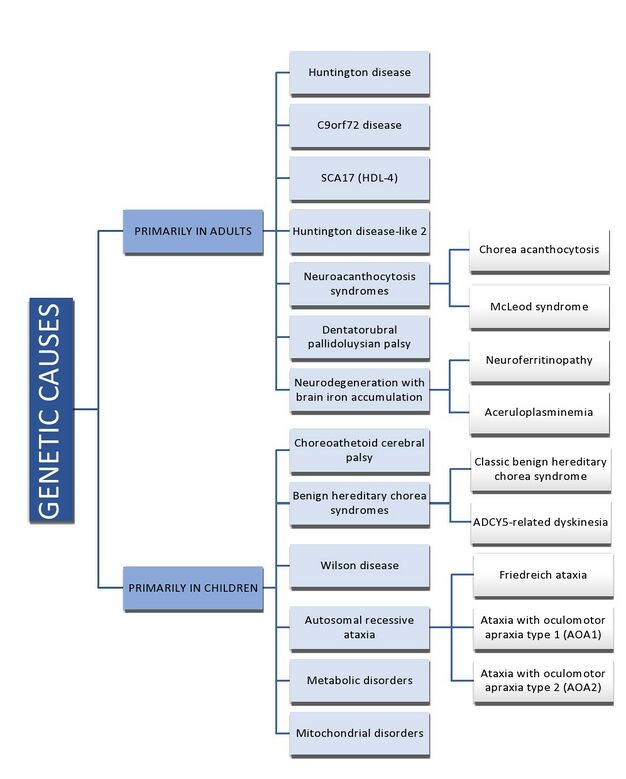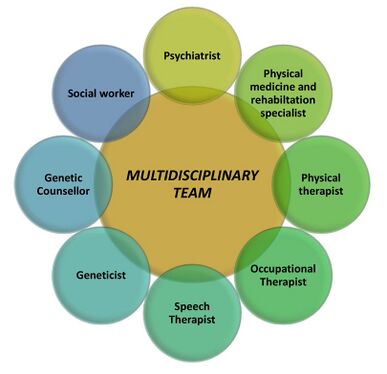Chorea: Difference between revisions
No edit summary |
No edit summary |
||
| Line 83: | Line 83: | ||
== Physiotherapy Management == | == Physiotherapy Management == | ||
The management will be same as of Huntington's Disease. You can read it [https://www.physio-pedia.com/Huntington_Disease?utm_source=physiopedia&utm_medium=search&utm_campaign=ongoing_internal#Physiotherapy_Management here]. | The management will be same as of Huntington's Disease. You can read it [https://www.physio-pedia.com/Huntington_Disease?utm_source=physiopedia&utm_medium=search&utm_campaign=ongoing_internal#Physiotherapy_Management here]. | ||
=== Goals of Management === | |||
* Gait re-education | |||
* [[Balance|Balance r]]<nowiki/>etraining | |||
* [[Falls|Fall]] prevention/management | |||
* Aerobic capacity | |||
* Muscle [[Strength and Conditioning|strengthening]] | |||
* [[Wheelchair Assessment|Wheelchair]] prescription and training | |||
* [[Respiratory Muscle Training|Respiratory]] function | |||
* Task-specific reach, grasp, and manipulation. | |||
==References== | ==References== | ||
[[Category:Neurology]] | [[Category:Neurology]] | ||
[[Category:Neurological - Conditions]] | [[Category:Neurological - Conditions]] | ||
Revision as of 17:03, 23 September 2022
Introduction[edit | edit source]
Chorea is defined as "a state of excessive, spontaneous movements, irregularly timed, non-repetitive, randomly distributed and abrupt in character. These movements may vary in severity from restlessness with mild intermittent exaggeration of gesture and expression, fidgeting movements of the hands, unstable dance-like gait to a continuous flow of disabling, violent movements."[1]
- The word Chorea has Greek origins meaning "to dance". It has a dance-like appearance due to the random and flowing quality of the movement.
- Chorea is a type of hyperkinetic movement disorder.
- The involuntary movements flow from one body area to another which cannot be predicted beforehand.
Etiology[edit | edit source]
Chorea traditionally is described in Huntington disease, however other disorders that can lead to chorea, for example: Spinocerebellar ataxia subtypes; Wilson disease; Sydenham chorea, and structural disease of the basal ganglia. Generally, the root of the pathology is in the basal ganglia.[1]
They are predominantly of 2 types[2]
- Acquired Causes
- Genetic Causes
Phenomenological Features[edit | edit source]
- Randomness
- Flowing Quality
- Parakinesia-Patients blend their chorea-induced movements with their own normal movements.
- Motor impersistence- the patient is unable to perform sustained motor activities.
- Ballism- Variant of chorea which shows large-amplitude flinging movements involving proximal extremities.
- Athetosis-Slow writhing movements involving distal limbs sometimes may be facing.
- Varying velocity of movements-quick velocity and low-amplitude movements accompanied by jerks.[2]
This video displays the dance-like movements performed by a patient.[3]
Diagnosis[edit | edit source]
The phenomenological features mentioned above are observed to make a diagnosis of chorea.
Differential Diagnosis[edit | edit source]
Specific diagnosis can be made on the basis of symptoms/clinical features experienced by the patient.[2]Differential diagnoses include:
- Huntington disease
- Lyme disease
- Multiple system atrophy
- Neuroacanthocytosis
- Pediatric torticollis surgery
- Ramsay Hunt syndrome
- Striatonigral degeneration
- Tourette syndrome
- Viral encephalitis[1]
Multimodal Management[edit | edit source]
Chorea requires a Multidisciplinary Approach to be treated.[4]
The team includes
- Psychiatrist
- Physical medicine and Rehabilitation Specialist
- Physical therapist
- Occupational therapist
- Speech therapists
- Geneticist
- Genetic Counselor
- Social worker
Medical Management[edit | edit source]
There is no cure for this disease but symptoms can be managed. Importantly an evaluation and creation of a patient's support system is needed. With disease progression, the patient will need specialized caregiving. Nutrition management is important, due to difficulty swallowing.[1]
1. Dopamine-depleting agents-Tetrabenazine, Deutetrabenazine, Valbenazine.
2. Dopamine D2 receptor-blocking agents-Haloperidol, Clozapine, Olanzapine.
3. Anticonvulsants- Valproic acid, Carbamazepine, Benzodiazepines, Levetiracetam.
4. Anti-glutamatergic agents-Amantadine, Riluzole.
5. Cannabinoids-Nabilone.
6. Deep Brain Stimulation
Physiotherapy Management[edit | edit source]
The management will be same as of Huntington's Disease. You can read it here.
Goals of Management[edit | edit source]
- Gait re-education
- Balance retraining
- Fall prevention/management
- Aerobic capacity
- Muscle strengthening
- Wheelchair prescription and training
- Respiratory function
- Task-specific reach, grasp, and manipulation.
References[edit | edit source]
- ↑ 1.0 1.1 1.2 1.3 Merical B, Sánchez-Manso JC. Chorea. Available: https://www.ncbi.nlm.nih.gov/books/NBK430923/#!po=15.0000(accessed 19.9.2022)
- ↑ 2.0 2.1 2.2 Termsarasab P. Chorea. CONTINUUM: Lifelong Learning in Neurology. 2019 Aug 1;25(4):1001-35.
- ↑ neurosigns.org. Chorea. Available from https://www.youtube.com/watch?v=RxWEilu-Mf4&ab_channel=neurosigns.org
- ↑ Feinstein E, Walker R. An update on the treatment of chorea. Current Treatment Options in Neurology. 2018 Oct;20(10):1-5.










